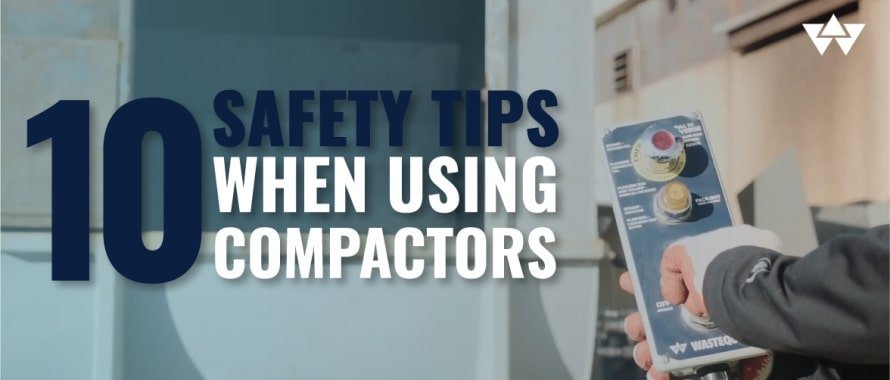10 Compactor Safety Tips
10 Tips for Compactor Safety
Republished: April 15th, 2023. Original Source: Wastebuilt >
Blog Post

For businesses that produce a substantial amount of waste, having an industrial trash compactor on-site can deliver a long list of benefits. Those include cost savings, improved sanitation, and reduced liabilities (largely as a result of eliminating the risks presented by people climbing into open dumpsters). But as with most any large equipment used at a worksite, a compactor can also present significant safety risks if workers don’t know how to use it correctly.
To ensure that safety risks are minimized, follow these 10 safety-focused tips at any workplace with an on-site compactor:
1. Ensure Adequate Training
It is critical to properly train any workers who will be using a commercial trash compactor. Employees without thorough compactor-safety training should never be allowed to operate the compactor and they should be required to stay clear of the area at any time the compactor is in use.
2. Perform Emergency Stop
It is also vitally important that all employees be trained on how to perform an emergency stop on the compactor, in case an emergency situation calls for the equipment’s immediate shutdown.
3. Proper Compactor Location
Before a location choice is finalized for a compactor, a few important considerations should be made. Among them, the compactor should be placed such that there is ample space for performing maintenance and repair work on the equipment when needed. Further, the location should allow enough space for any accessories like conveyors and chutes that may be employed. And if the compactor needs to be near a specific storage area or waste-handling area, proper proximity should be ensured.
4. Be Clear & Stand Clear
Workers should never place hands, arms or other body parts into the compactor for any reason, such as to rearrange any waste materials that may be causing the equipment to jam. To reach any material that needs to be relocated or moved within the compactor’s “danger zone,” a long rod or staff should be employed.
5. Proper Safety Equipment
As mentioned above, one essential accessory that should always be kept within easy reach of the compactor is a long rod or staff, which can be used to move or shift items in the compactor as needed for a proper fit — without having to reach any hands, arms or other body parts into the compactor. In addition, to provide safe access when clearing any jams, platforms with stairs and railings should be made available near the compactor’s feed-chute opening.
Further, depending on the nature of the waste materials being handled, some employers may want employees to wear PPE such as gloves and safety glasses when handling the waste being loaded into the compactor, all in an effort to prevent cuts, scrapes and other abrasions. And if recommended by the compactor manufacturer or the employer, ear plugs, safety goggles and hard hats may also be required as safety accessories during compactor operation.
6. Compactor Load Limits
All employees trained to use the compactor should also be made aware of the compactor’s load limits. Overloading a trash compactor can result in safety risks and equipment damage that may require the need for costly repairs.
7. Look For Animals Before Loading
While keeping the compactor door closed when the equipment is not in use should prevent intrusion by scavenging animals such as raccoons or cats, it’s a good idea to always give the equipment a quick visual scan before loading it to make sure that no such animals end up trapped inside during usage.
8. Close Compactor Doors
Before starting operation of the compactor, its door should be closed, and it should never be opened while the equipment is in use. Likewise, all guards should be kept in place during operation.
9. Routine Maintenance & Repairs
A regular maintenance routine that follows manufacturer guidelines should be put in place for any on-site trash compactor, and repairs should be performed as needed. When a need for compactor repair has been identified, the equipment should not be operated.
10. Lockout & Tagout Procedures
When maintenance and repairs are performed, it is essential that strict lockout/tagout procedures are in place and rigorously followed. Lockout/tagout training for any compactor-service personnel should include and cover:
- A clear rundown of all equipment hazards
- ID and clear labeling of all power disconnects
- Steps for securing and shutting down the compactor
- A designated placement for all lockout/tagout devices, along with clear guidelines regarding who is responsible for them
- An explicit notification procedure that must be followed before application and removal of lockout/tagout devices
Further Boost Safety With Wastequip Training
Of course, keeping any large equipment on a work campus well-maintained and functioning properly is also essential to worker safety. And Wastequip’s compactor-training workshops can teach service technicians all the ins and outs of compactor maintenance and repair.
The
two-day,
hands-on workshops cover a range of topics related to compactor upkeep and technical service, including:
- Plant tour
- Hydraulics
- Electrical theory
- Hands-on hydraulic and electrical demonstrations
- Troubleshooting systems
- Application of classroom knowledge to achieve solutions
- GuardianTM Control System
- American National Standards Institute (ANSI)
- Lockout/tag procedures
- Review of Precision Series compactors
Upon successful course completion, attendees receive a service manual, a training completion certificate, and an electric voltmeter.
